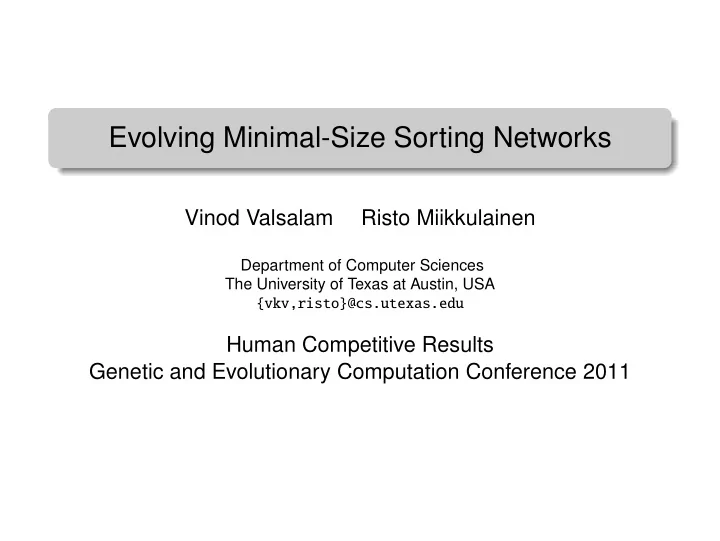

Evolving Minimal-Size Sorting Networks Vinod Valsalam Risto Miikkulainen Department of Computer Sciences The University of Texas at Austin, USA {vkv,risto}@cs.utexas.edu Human Competitive Results Genetic and Evolutionary Computation Conference 2011
Sorting Networks Nvidia GT200 GPU die ◮ Sequence of comparators for sorting n inputs ◮ Data-independent sorting algorithm ◮ Used in parallel hardware ◮ Fast sorting is crucial ◮ Multi-core GPUs, switching, multi-access memories, . . .
A Challenging Optimization Problem 6 comparators 5 comparators ◮ Minimize size (i.e. number of comparators) ◮ Provably minimal size networks known only for n ≤ 8 ◮ Suboptimal heuristic methods for n > 8
Human Designs for n ≤ 8 Batcher’s network for 8 inputs ◮ Provably optimal ◮ O’Conner and Nelson [1962], U.S. Patent 3029413 ◮ Hand-designed networks for 4 ≤ n ≤ 8 ◮ 7-input network required two extra comparators ◮ Batcher’s [1968] recursive merge algorithm ◮ Optimal only for n ≤ 8
Human Designs for 8 < n ≤ 16 Hand-designed 16-input network with 60 comparators [Green, 1969] ◮ Optimality not known ◮ Constructed using special techniques ◮ Human designs (except for n = 13 [Juille, 1995])
Human Designs for n > 16 Hand-designed 16-input network with 60 comparators [Green, 1969] ◮ Only merges of smaller networks are known
SENSO Approach Utilizing Symmetry and Evolution ◮ SENSO = Sorting ENSO method ◮ Add comparators greedily to build symmetry step-by-step ◮ Focuses evolution on promising solutions ◮ Utilize an EDA (evolution) to improve greedy solutions ◮ Evolution learns to anticipate minimal solutions
Results Evolved by SENSO 1 2 3 4 5 6 7 8 9 10 11 12 n Prev best 0 1 3 5 9 12 16 19 25 29 35 39 SENSO 0 1 3 5 9 12 16 19 25 29 35 39 13 14 15 16 17 18 19 20 21 22 23 24 n Prev best 45 51 56 60 73 80 88 93 103 110 118 123 SENSO 45 51 57 60 71 78 86 92 103 108 118 125 ◮ Matched previous best results for n < 24 , n � 15 ◮ Improved previous best results for n = 17 , 18 , 19 , 20 , 22 ◮ Potential for more: is still running!
Human-Competitiveness Criterion A: Patentability A new minimal 22-input network evolved by SENSO ◮ Do the results match or improve upon patented inventions? ◮ U.S. Patent 3029413 for the simpler 4 ≤ n ≤ 8 cases ◮ SENSO results therefore qualify as patentable inventions
Human-Competitiveness Criteria B, D: Publishability A new minimal 20-input network evolved by SENSO ◮ Are the results equal to/better than published results? (B) ◮ Are the results publishable as new scientific results? (D) ◮ Many journal publications on minimal sorting networks ◮ See Knuth [1998] and Koza et al. [1999] for surveys ◮ SENSO improved several upper bounds ⇒ publishable
Human-Competitiveness Criteria E, F, G: Difficulty A new minimal 19-input network evolved by SENSO ◮ Equal to/better than a succession of human designs? (E) ◮ Equal to/better than an achievement in the field? (F) ◮ Solves a problem of indisputable difficulty? (G) ◮ Knuth [1998] and Koza et al. [1999] discuss the history ◮ SENSO scaled to larger networks and improved results
Why is this the Best Entry? A new minimal 20-input network evolved by SENSO Nvidia GT200 GPU die 1. Not only satisfies humies criteria A, B, D, E, F , and G 2. But also improves upon half-century of theoretical results ◮ Published in patents, books, peer-reviewed literature 3. And has significant practical value ◮ More efficient sorting, switching, memories . . . http://nn.cs.utexas.edu/?sorting-code
Recommend
More recommend